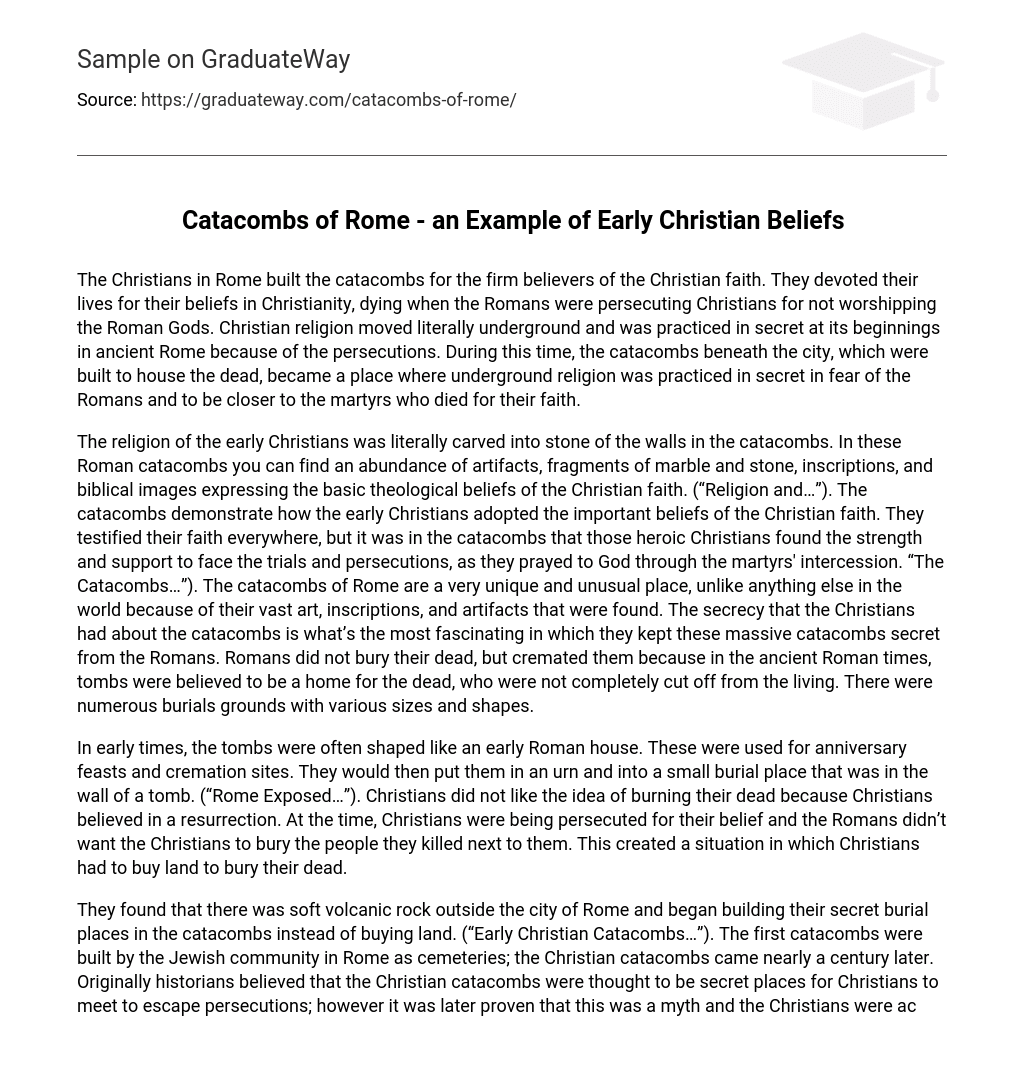The Catacombs in Rome were established by Christians as a sanctuary for dedicated followers of their faith. These individuals committed themselves to Christianity and faced persecution from the Romans because they refused to worship the Roman Gods. As a result, the Christian religion had to operate clandestinely within ancient Rome. Originally designed as burial grounds, the catacombs transformed into hidden sites for these secretive religious rituals, allowing believers to worship without fear of Roman authorities while also honoring the martyrs who sacrificed their lives for their convictions.
The catacombs of Rome are an exceptional and extraordinary place, unlike anything else in the world. They were utilized by early Christians to express their religious beliefs through artifacts, marble and stone fragments, inscriptions, and biblical images. These catacombs served as a testimony to their faith and provided strength and support during times of trials and persecutions. Within the catacombs, Christians prayed to God with the intercession of the martyrs. It is intriguing how they managed to keep them hidden from the Romans who practiced cremation instead of burial for their deceased. In ancient Roman times, tombs were perceived as a dwelling for both the dead and the living. Different burial grounds existed in diverse sizes and shapes.
During early times, tombs resembled early Roman houses and served as venues for anniversary feasts and cremation sites. The ashes of the deceased were placed in an urn and placed within a small burial spot within the tomb’s wall (“Rome Exposed…”). However, Christians, who believed in resurrection, opposed the practice of cremation. As Christians were being persecuted, the Romans prohibited them from burying their deceased alongside those they had killed. Consequently, Christians were forced to purchase land for burial purposes.
The catacombs in Rome, originally built by the Jewish community as burial places, were later joined by the construction of Christian catacombs. Initially thought to be secret meeting spots for persecuted Christians seeking refuge, it was eventually revealed that they primarily functioned as burial tunnels, much like the Jewish catacombs.
The catacombs expanded due to the Christians’ desire to be buried close to their religious leaders. Initially, the secrecy surrounding the catacombs stemmed from the belief that Christians used these tunnels as hidden meeting places to evade persecution. Georg Simmel’s assertion that the level of secrecy in a relationship defines its nature applies to this context. In everyday life, we can reflect on what measures individuals would take to safeguard their faith.
Just like the Christians in Rome, some individuals would resort to deceit and seek refuge in hidden burial tombs to safeguard their deeply held beliefs. The object of their protection is our very humanity, wellness, and intellect. We all possess undisclosed truths, yet the primary motive behind keeping secrets or telling lies is to maintain “peace.” We cling onto secrets to ensure the happiness, safety, and adherence to the established worldview others have of the world and of ourselves (Brower, Elena). Similarly, the Christians in Rome pursued peace with the Romans to avoid persecution and appease them to prevent further mistreatment of fellow Christians.
The catacombs were a hidden space used by Christians to share their beliefs and stories. The art found in the catacombs offers understanding of early Christian beliefs. Because Christians couldn’t openly practice their faith, they used symbols like the dove, fish, and good shepherd with his sheep. These symbols are displayed on the walls and marble-slabs sealing the tombs in the catacombs. Additionally, there are various types of mural paintings in the catacombs.
The catacombs contain paintings that depict biblical scenes from both the Old and New Testament. Rather than simply illustrating stories, these paintings offer interpretations of the Bible (“Early Christian Art”). The catacombs are a source of fascination for individuals who are attracted to this mysterious and unfamiliar world, which offers adventure, discovery, and even relaxation. Those who are drawn to the catacombs, known as ‘cataphiles,’ form a secret group of daring explorers. Only those brave enough to explore the networks on their own and break the law are aware of the catacomb entrances.
Loic Antoine-Gambeaud and his companions are adventurous enough to explore the enigmatic underground of Paris. According to Antoine-Gambeaud, there is a communal vision about what lies beneath the city, but only a few truly comprehend its nature (Sealy, Amanda). The catacombs are an intriguing location where both corpses and artwork coexist. It preserves our historical heritage and remains largely unexplored by many Americans.
These catacombs are fascinating to many tourists because they differ from anything anyone has ever seen. The extent to which individuals go to preserve their beliefs and stories intrigues people.
Works Cited: “Early Christian Art.” Early Christian Art (Symbols, Catacombs, Typology). N. p., n. d. Web. 31 Oct. 2012. “Early Christian Catacombs, RomeA.” Early Christian Catacombs. N. p., n. d. Web. 31 Oct.
2012.“Religion and the Catacombs – CIC.” Religion and the Catacombs – CIC.N.p.,n.d.Web .31Oct.
2012.“Rome Exposed – The Romans and Their Dead.” Rome Exposed -The Romans and Their Dead.
“N. p., n. d. Web. 31 Oct. 2012. ‘The Catacombs: Importance.’ EarlyChristians.org || Catacombs – Importance. N. p., n. d. Web. 31 Oct. 2012. ‘What’s Inside Rome’s Ancient Catacombs?’ National Geographic. National Geographic Society, n. d. Web. 23 Oct. 2012. Brower, Elena. ‘Understanding Why We Keep Secrets.’ The Huffington Post. The Huffington Post.com, 16 May 2011. Web. 23 Oct. 2012. Sealy, Amanda. ‘Loving Life in Paris’ Empire of the Dead – CNN.com.’ CNN. Cable News Network, 01 Jan. 1970. Web. 31 Oct. 2012. Simmel, Georg. BrainyQuote. Xplore, n.d.Web .23 Oct 2012.”





